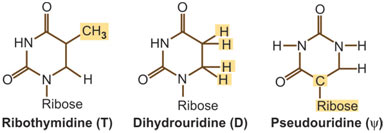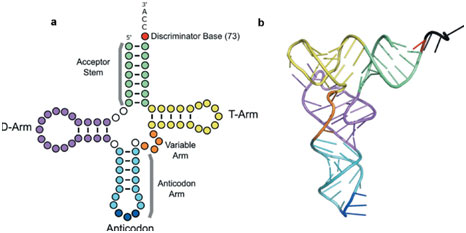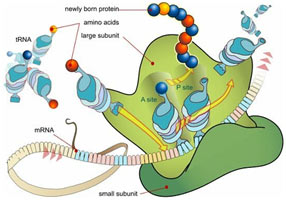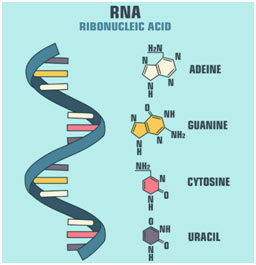Abstract
- RNA is a linear, unbranched and single-stranded polymer of ribonucleotides joined by phosphodiester bonds.
- Consists of four bases– adenine (A), uracil (U), cytosine (C), or guanine (G).
- RNA is of three types. mRNA is manufactured in the nucleus as heterogenous RNA (hnRNA), which is processed into functional mRNA.
- In eukaryotes, mRNAs are “capped” by a 7- methyl-guanosine triphosphate. Transfer RNA molecules differ in length from 74 to 95 nucleotides.
- The RNA of the ribosomes is called the rRNA. Having two subunits, each subunit is made up of several strands of rRNA and many protein molecules.
- The 60S subunit contains 28S rRNA, 5S rRNA, and 5.8 S rRNA, while the 40S subunit contains 18S rRNA. RNA is the carrier of genetic information, serves as an adaptor molecule, and provides catalytic activities.
- 1) What is RNA?
- 2) Types of RNA
- 3) Messenger RNA (mRNA)
- 4) Structure of mRNA
- 5) Function of mRNA
- 6) Transfer RNA (tRNA)
- 7) Structure of tRNA
- 8) Ribosomal RNA (rRNA)
- 9) Other Nuclear and Cytoplasmic RNAs
- 10) Functions of RNA
- 11) FAQs: RNA Structure, Types, and Functions
- 12) Multiple-Choice Questions (MCQs) with Answers about RNA
- 13) Conclusion:
- 14) You may also like to learn:
What is RNA?
Unlike double-stranded helical structure of DNA, the RNAs are single-stranded. RNA is an unbranched linear polymer of ribonucleotides joined by 3′, 5′ phosphodiester bonds. The phosphodiester bonds join with the 3′- OH group of ribose of one nucleotide group to the 5′- OH group of ribose sugar of the next nucleotide. Connected to each sugar is one of four bases– adenine (A), uracil (U), cytosine (C), or guanine (G).
Types of RNA
The cell consists of three significant types of RNA:
- Messenger RNA (mRNA)
- Transfer RNA (tRNA)
- Ribosomal RNA (rRNA)
All of these are associated with the process of protein biosynthesis. Each varies from the others by size and function.
Messenger RNA (mRNA)
The mRNA makes up just about 5-10% of overall cellular RNA.mRNA is manufactured in the nucleus as heterogenous RNA (hnRNA), which are processed into functional mRNA.
The mRNA carries the hereditary information in the form of codons. Codons are a group of three surrounding nucleotides that code for the amino acids of the protein. In eukaryotes mRNAs have some distinct characteristics, e.g. the 5′ end of mRNA is “capped” by a 7- methyl-guanosine triphosphate. The cap is associated with the recognition of mRNA in protein biosynthesis and it helps to stabilize the mRNA by avoiding the attack of 5′- exonucleases.
A poly (A) “tail” is connected to the other 3′- end of mRNA. This tail includes a series of adenylate residues, 20-250 nucleotides in length joined by 3′ to 5′ phosphodiester bonds. The function of poly A tail is not completely understood, but it seems that it assists to support mRNA by avoiding the attack of 3′- exonuclease.
Structure of mRNA

Function of mRNA
mRNAs work as a design template for protein biosynthesis and transfer hereditary information from DNA to protein manufacturing machinery. If the mRNA codes for only one peptide, the mRNA is monocistronic. If it codes for two or more different polypeptides, the mRNA is polycistronic. In eukaryotes most mRNA is monocistronic.
Transfer RNA (tRNA)
Transfer RNA molecules differ in length from 74 to 95 nucleotides. In eukaryotic cells, 10-20% of the nucleotides of tRNA may be modified and known as unusual nucleotides. Some of them are:
- Dihydrouridine (D), in which one of the double bonds of the base is reduced.
- Ribothymidine (T), in which the methyl group is added to uracil to form thymine.
- Pseudouridine (ψ), in which uracil is connected to ribose by a carbon-carbon bond rather than a nitrogen bond.

Structure of tRNA
All single-stranded transfer RNA molecules get folded into a structure that resembles a cloverleaf. All tRNAs include 4 main arms:
- The acceptor arm
- The D arm
- The anticodon arm
- The TψC arm
The arms have base-paired stems and unpaired loops. The structure of tRNA molecules is preserved by the base-pairing in these arms or stem regions.
- The acceptor arm
The acceptor arm consists of a base paired stem that ends in the sequence CCA at the 3′ end. This is the attachment site for the amino acid.
- The D arm
The D arm is named for the existence of the base dihydrouridine (D).
- The anticodon arm
The anticodon arm consists of the anticodon that base pairs with the codon on mRNA. Anticodon has a nucleotide sequence complementary to the codon of mRNA and is accountable for the uniqueness of the tRNA.
- The TψC arm
The TψC arm contains both ribothymidine (T) and pseudouridine (ψ, psi).
The additional arm is likewise referred to as a variable arm because it varies in size, is found between the anticodon and TψC arms.

Function of tRNA
Transfer RNA carries amino acids in an activated type to the ribosome for protein synthesis.
Ribosomal RNA (rRNA)
The RNA of the ribosomes is called the rRNA. A ribosome is a cytoplasmic nucleoprotein that functions as a machinery for the synthesis of proteins. The ribosome is a spheroidal particle and is composed of a big and a small nucleoprotein subunit. The eukaryotic ribosomes are composed of 60S and 40S subunits. Each subunit is made up of several strands of rRNA and many protein molecules. The 60S subunit contains 28S rRNA, 5S rRNA, and 5.8 S rRNA, while the 40S subunit contains 18S rRNA.

Functions of ribosomal RNA
The function of the ribosomal RNA molecules in the ribosomal particle are not totally comprehended, but they are:
- Required to keep the ribosomal structure and also take part in protein synthesis by binding of mRNA to ribosome.
- Recent studies reveal that ribosomal RNAs may likewise supply a few of the catalytic activities and hence is an enzyme “a ribozyme”.
Other Nuclear and Cytoplasmic RNAs
Besides mRNA, tRNA, and rRNA, eukaryotes have some other RNAs. These are:
– Heterogenous RNAs (hnRNAs)
– Small cytoplasmic RNAs (scRNAs)
– Small nuclear RNAs (snRNAs)
Functions of RNA
Overall functions of RNAs are:
- Carries the hereditary information from DNA to the cytosol, where it is utilized for protein synthesis.
- Acts as an “adaptor” molecule that brings particular amino acid to the site of protein synthesis.
- In association with protein functions as the sites for protein synthesis. Provides catalytic activities (peptidyl transferase activity).
- Works as a precursor for mRNA.
- Associated with recognition of signal sequence in protein synthesis on membrane-bound ribosomes.
- Associated with excising introns and splicing exons.
FAQs: RNA Structure, Types, and Functions
1. What is RNA, and how does it differ from DNA?
- RNA is a linear, single-stranded polymer of ribonucleotides, distinct from the double-stranded helical structure of DNA. It carries genetic information and plays a vital role in protein synthesis.
2. What are the three main types of RNA?
- The three significant types are:
- Messenger RNA (mRNA)
- Transfer RNA (tRNA)
- Ribosomal RNA (rRNA)
3. What is the role of mRNA in protein biosynthesis?
- mRNA serves as a template for protein biosynthesis, carrying genetic information in the form of codons that code for amino acids. It undergoes processing, including capping and polyadenylation.
4. How is tRNA structured, and what functions does it perform?
- tRNA adopts a cloverleaf-like structure with four main arms. It carries amino acids to the ribosome for protein synthesis, recognizing codons on mRNA through its anticodon arm.
5. What are the functions of rRNA in ribosomes?
- rRNA maintains ribosomal structure, facilitates protein synthesis by binding mRNA to the ribosome, and recent studies suggest it may have catalytic activities, acting as a ribozyme.
6. Are there other types of RNA in eukaryotic cells?
- Yes, besides mRNA, tRNA, and rRNA, eukaryotic cells contain other RNAs like Heterogenous RNAs (hnRNAs), Small Cytoplasmic RNAs (scRNAs), and Small Nuclear RNAs (snRNAs).
7. What are the overall functions of RNA?
- RNA acts as a genetic information carrier, an adaptor molecule for amino acids, a site for protein synthesis, and provides catalytic activities. It is involved in mRNA precursor formation and plays a role in recognizing signal sequences in protein synthesis.
8. How is RNA involved in intron splicing and exon processing?
- RNA is engaged in excising introns and splicing exons, contributing to the maturation and processing of mRNA.
9. What modifications can be found in tRNA?
- tRNA can have modified nucleotides like Dihydrouridine (D), Ribothymidine (T), and Pseudouridine (ψ), contributing to its structural and functional diversity.
10. How does RNA differ from DNA in terms of structure and function? – Unlike the double-stranded helical structure of DNA, RNA is single-stranded and plays crucial roles in protein synthesis, carrying genetic information from DNA to the cytosol.
Multiple-Choice Questions (MCQs) with Answers about RNA
1. What is RNA?
- A. Double-stranded helical structure
- B. Single-stranded linear polymer
- C. Branched polymer
- D. Double-stranded linear polymer
Answer: B. Single-stranded linear polymer
2. How many types of RNA are mentioned in the tutorial?
- A. One
- B. Two
- C. Three
- D. Four
Answer: C. Three
3. What are the bases present in RNA?
- A. Adenine (A), Thymine (T), Cytosine (C), Guanine (G)
- B. Adenine (A), Uracil (U), Cytosine (C), Guanine (G)
- C. Adenine (A), Uracil (U), Cytosine (C), Thymine (T)
- D. Adenine (A), Thymine (T), Cytosine (C), Synthine (S)
Answer: B. Adenine (A), Uracil (U), Cytosine (C), Guanine (G)
4. What type of RNA is involved in protein biosynthesis?
- A. mRNA
- B. tRNA
- C. rRNA
- D. All of the above
Answer: D. All of the above
5. What is the function of the 5′ cap in mRNA?
- A. Enhances mRNA stability
- B. Initiates translation
- C. Protects against exonuclease attack
- D. All of the above
Answer: D. All of the above
6. Which arm of tRNA contains the anticodon?
- A. Acceptor arm
- B. D arm
- C. Anticodon arm
- D. TψC arm
Answer: C. Anticodon arm
7. What is the primary function of tRNA?
- A. Carry amino acids to the ribosome
- B. Act as a template for protein synthesis
- C. Bind mRNA to the ribosome
- D. Carry genetic information
Answer: A. Carry amino acids to the ribosome
8. Which component of the ribosome has catalytic activities, acting as a ribozyme?
- A. mRNA
- B. tRNA
- C. 28S rRNA
- D. 18S rRNA
Answer: C. 28S rRNA
9. Besides mRNA, tRNA, and rRNA, what are the other RNA types in eukaryotes mentioned in the tutorial?
- A. Transfer RNAs (tRNAs)
- B. Heterogenous RNAs (hnRNAs)
- C. Small cytoplasmic RNAs (scRNAs)
- D. All of the above
Answer: D. All of the above
10. What does RNA act as in protein synthesis on membrane-bound ribosomes?
- A. Adaptor molecule
- B. Precursor for mRNA
- C. Carrier of genetic information
- D. Initiator of translation
Answer: A. Adaptor molecule
11. What does the poly(A) “tail” in mRNA primarily contribute to?
- A. mRNA stability
- B. Initiating translation
- C. Binding to ribosomes
- D. Exonuclease attack prevention
Answer: A. mRNA stability
12. In eukaryotes, what modification is observed in 10-20% of nucleotides in tRNA?
- A. Methyl group addition
- B. Base reduction
- C. Carbon-carbon bond formation
- D. Phosphodiester bond cleavage
Answer: A. Methyl group addition
13. Which type of RNA is monocistronic in most eukaryotes?
- A. mRNA
- B. tRNA
- C. rRNA
- D. hnRNA
Answer: A. mRNA
14. What is the size range of tRNA molecules?
- A. 50-70 nucleotides
- B. 74-95 nucleotides
- C. 100-150 nucleotides
- D. 200-250 nucleotides
Answer: B. 74-95 nucleotides
15. What is the function of the D arm in tRNA?
- A. Amino acid attachment
- B. Base reduction
- C. Codon recognition
- D. Carbon-carbon bond formation
Answer: B. Base reduction
16. How many subunits make up eukaryotic ribosomes, and what are their sizes?
- A. One subunit: 60S
- B. One subunit: 40S
- C. Two subunits: 40S and 60S
- D. Two subunits: 30S and 50S
Answer: C. Two subunits: 40S and 60S
17. What is the primary function of small nuclear RNAs (snRNAs) in eukaryotes?
- A. Carry amino acids
- B. Participate in protein synthesis
- C. Involved in splicing exons
- D. Function as an adaptor molecule
Answer: C. Involved in splicing exons
18. What role does RNA play in recognizing signal sequences in protein synthesis on membrane-bound ribosomes?
- A. mRNA
- B. tRNA
- C. rRNA
- D. snRNA
Answer: A. mRNA
19. What does RNA serve as during protein synthesis?
- A. Precursor for DNA
- B. Adaptor molecule
- C. Initiator of translation
- D. Carrier of genetic information
Answer: B. Adaptor molecule
20. What is the unique feature of the TψC arm in tRNA?
- A. Amino acid attachment
- B. Codon recognition
- C. Contains pseudouridine (ψ)
- D. Base reduction
Answer: C. Contains pseudouridine (ψ)
21. Which base is unique to RNA and absent in DNA?
- A. Adenine (A)
- B. Uracil (U)
- C. Cytosine (C)
- D. Guanine (G)
Answer: B. Uracil (U)
22. What type of bonds join ribonucleotides in an RNA polymer?
- A. Peptide bonds
- B. Glycosidic bonds
- C. Phosphodiester bonds
- D. Hydrogen bonds
Answer: C. Phosphodiester bonds
23. What is the primary function of the 5.8S rRNA in eukaryotic ribosomes?
- A. mRNA stability
- B. Catalytic activity
- C. Initiating translation
- D. Codon recognition
Answer: B. Catalytic activity
Conclusion:
In conclusion, this comprehensive guide sheds light on the intricate world of RNA—its structure, diverse types, and multifaceted functions within the cellular machinery. RNA, as a linear and single-stranded polymer of ribonucleotides, stands as a vital player in the transmission of genetic information. Comprising adenine (A), uracil (U), cytosine (C), and guanine (G), RNA manifests itself in three pivotal forms: Messenger RNA (mRNA), Transfer RNA (tRNA), and Ribosomal RNA (rRNA).The uniqueness of RNA, distinguished from the double-stranded DNA helix, lies in its unbranched linear structure linked by 3′, 5′ phosphodiester bonds. Each RNA type carries out specialized roles, with mRNA acting as the blueprint for protein biosynthesis and tRNA facilitating the transportation of amino acids to the ribosome. The ribosome, composed of rRNA and proteins, serves as a crucial cellular machinery for protein synthesis.
Eukaryotic mRNAs, capped at the 5′ end and adorned with a poly(A) tail, undergo intricate processing, emphasizing their importance in the regulation of protein synthesis. The detailed exploration of tRNA unfolds its distinctive cloverleaf structure, harboring essential arms like the anticodon arm responsible for codon recognition.
The enigmatic realm of rRNA, found in ribosomes, still harbors mysteries regarding its precise functions. Recent studies hint at its potential catalytic role, transforming it into an intriguing entity—a ribozyme.
Beyond the triumvirate of mRNA, tRNA, and rRNA, other RNA players such as hnRNAs, scRNAs, and snRNAs contribute to the orchestration of cellular activities. Collectively, RNA serves as a genetic courier, an adaptor molecule, and even a catalytic entity, participating in diverse processes such as splicing exons, excising introns, and recognizing signal sequences.
This guide not only unravels the fundamental aspects of RNA but also invites the curious minds to delve deeper into the intricate world of molecular biology, where the language of RNA orchestrates the symphony of life.

